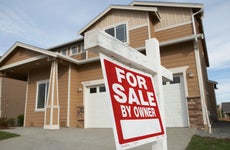‘Unmortgaged millennials’: What a new study reveals about millennial homebuyers

The Bankrate promise
At Bankrate we strive to help you make smarter financial decisions. While we adhere to strict , this post may contain references to products from our partners. Here's an explanation for .
Millennials — those between ages 26 and 41, also sometimes called Generation Y — now represent the biggest population cohort in America. And while lots of them dream of homeownership, many find themselves priced out of the housing market. In fact, nearly half of millennials who do not yet own a home are pessimistic that they may ever be able to, according to a recent study on the generation by Opendoor.
Here, we take a closer look at the 2022 Millennial Homebuying Trends Report to learn more about this important demographic’s homeownership preferences, challenges and trends.
Millennials and homebuying
It’s clear that millennials who want to own a home face many hurdles, especially compared to older generations. A 2022 report by the National Association of Realtors reveals that Gen Y represents the largest share of homebuyers in the country, at 43 percent. That includes the biggest percentage of first-time purchasers as well.
However, 28 percent of Gen Y buyers had to delay saving for a down payment or purchasing a home for more than five years due to outstanding debt. They are also the most educated group of homebuyers, according to NAR, and younger millennials in particular had the highest share of student loan debt at 45 percent. The sacrifices millennials make to buy a home include spending less on entertainment, clothes and vacations; picking up a second job to earn extra income; and moving in with family or friends to save on rent.
What is an ‘unmortgaged millennial’?
“Unmortgaged millennials want to own a home, but they feel like the odds are stacked against them,” says Beatrice de Jong, consumer trends expert for Opendoor. Fact is, plenty of millennials have never owned a home. This study takes a magnifying glass to the generation, coining the term to refer to millennials who have yet to become homeowners, despite being at prime buying age. “We came to this term when trying to figure out how to classify this group,” says de Jong.
What millennials want — and don’t want
As it turns out, millennial desire to own a home is strong. The report contains some interesting findings, including:
- 69 percent of millennials would prefer homeownership to renting
- 54 percent want a home to raise a family in
- 51 percent yearn for better living conditions
- 50 percent are tired of paying rent to a landlord
- 62 percent are willing to relocate more than 50 miles away to purchase a home, with 1 in 5 prepared to move more than 500 miles away
- 52 percent have felt an increased urgency to own a home over the past year
- 49 percent aren’t confident they will ever become a homeowner
- 56 percent have less than $25,000 in savings
- 47 percent would be willing to delay vacations for five years if it saved them enough to buy a home
- 66 percent use real estate apps
Affordability, of course, is the biggest obstacle. Among the factors preventing millennials from purchasing are rising home prices (45 percent), low income (42 percent), poor credit (39 percent), job instability (31 percent) and outstanding debt (30 percent). Most rank saving for a down payment as their top financial goal, over paying off student loans (29 percent), saving for travel (22 percent) and saving for a new car (21 percent).
De Jong finds many of these results surprising. “We were heartened, for example, that unmortgaged millennials value real estate apps ahead of dating apps, travel apps and sports betting apps,” she says.
Tom Parrish, head of Retail Lending Product Management at BMO Harris Bank in Chicago, says one thing in particular caught him off guard: millennials’ willingness to move a substantial distance away to purchase a home. “That willingness to relocate may be because of remote and flexible work environments becoming more common,” he says. “This expands the ability to find the right home, which could include discovering more affordable options, more space and a home in an area that meets that individual’s desired lifestyle.”
The generation’s disdain for renting also shines through, particularly being subject to a landlord’s rules and rent hikes. “Most millennial renters have probably experienced all of the little ways that renting makes life harder,” says Martin Orefice, founder of Rent To Own Labs in Chicago. “They don’t have the freedom to repair or renovate their living space, they may have to put up with showings and they don’t have much say in how close their neighbors get. These are all good reasons to aspire to homeownership.”
Major takeaways
Collectively, the statistics gleaned from the report paint a clear picture: Millennials see homeownership as a way to improve their lives. But sadly, the goal is still out of reach for much of this massive segment of the population.
“Our data show that the majority of millennials are willing to tackle short-term challenges in exchange for the long-term satisfaction of being a homeowner,” says de Jong. “Unmortgaged millennials prioritize saving money for a down payment, but they feel challenged by rising home prices and low income.”
It’s certainly true that median home prices have increased significantly in recent years. “As a result, many feel priced out of the housing market,” says Boyd Rudy, a broker with Dwellings in Plymouth, Michigan.
Parrish agrees. “The findings underscore the fact that millennials understand the value and financial benefits that owning a home brings,” he says. “Because rising home costs are a commonly reported challenge, it’s crucial to know what you can afford and to talk with a mortgage advisor who can explain loan options to prepare for the homebuying journey,” he says.
Getting on the path to homeownership
If you’re an unmortgaged millennial determined to own a place of your own, don’t give up on the dream. Take smart financial steps now to help strengthen your position as a prospective homebuyer.
- Work to pay down as much outstanding debt as possible, and aim to up your credit score, which can help you qualify for better loan options.
- “Get a good handle on your financials,” says Parrish. “Understand how much you have coming in, what you owe each month, what you have saved up and what you [will have left over] for the unexpected after making a down payment.”
- “It’s also a good idea to get preapproved for a mortgage early in the process, so that you know how much you can spend,” says Rudy.
- If you aren’t eligible for a conventional mortgage loan, explore alternative financing methods. “Federal agencies like the FHA, USDA and VA offer loans to first-time buyers with much lower down payment requirements,” Orefice points out.
- Follow along with Bankrate’s series of articles that guide first-time homebuyers through the journey — and get first-person advice from one of our own editors.
Related Articles


Buying amid affordability squeeze? Here’s how homebuyers can cope


Nearly two-thirds of millennials have homebuyer regrets, survey finds